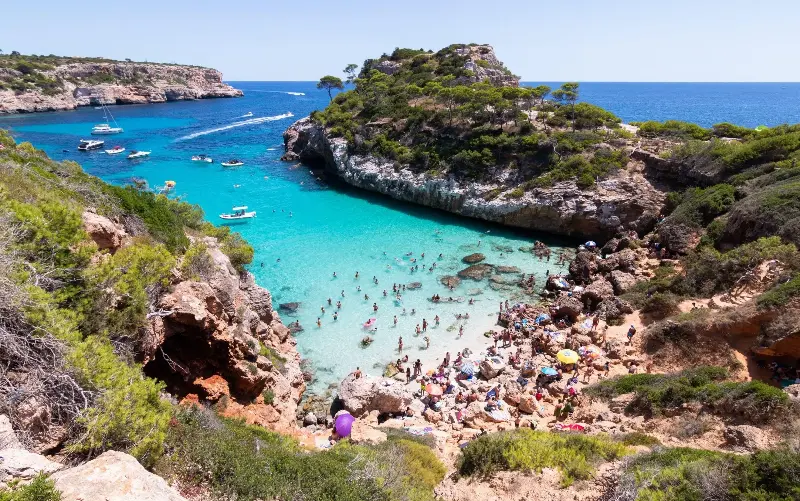
Last summer as many as 4,000 visitors and 1,200 cars descended daily on Caló des Moro in the south-east of Mallorca. A tiny cove which at best, can only accommodate about 100 people.
Unlike Es Trenc – a 25-minute drive away, with its two-kilometres of fine white sand, safe swimming, facilities and ample parking – Caló des Moro is cramped and rocky and reaching it requires a long schlep along rough tracks.
Yet hordes of people attempted to navigate this descent, often turning back due to the long wait and extreme heat. There are no amenities and only a tiny strip of sand, meaning most visitors have to perch on uncomfortable rocks – if they can find a space at all.
Mallorca has more than 260 lush beaches, many of which are far more bewitching than diminutive Caló des Moro.
So how on earth did this disaster unfold?
Last summer, in an attempt to direct tourists away from island hotspots such as Cala de Deià in the north-west (mobbed from June to October), social media influencers were encouraged by some island tourism entities to visit this petite cove and other lesser-known spots.
The well-meant strategy backfired, however, and before long influencers had turned Caló des Moro into a chaotic jam of tourists, with the social media set’s beguiling images and videos of Mallorca’s “best kept secret” luring their followers to the beach in droves.
To date, 1,300 videos of the cove have been uploaded to the TikTok platform, receiving an estimated 10 million views globally. Instagram currently has 30 associated hashtags.
Frustrated locals voiced their outrage, prompting the citizen movement, Mallorca Platja Tour, to stage a protest attended by more than 300 people. Bewildered tourists were pressured to leave the area, while victorious locals occupied every inch of space on the rocks and sand.
Martí Picornell, Head of Communications at the local Santanyi Town Council, responded by saying: “The Santanyí Tourism Department hasn’t used the image of Caló des Moro for publicity purposes in years. Local residents are exhausted by the situation, which is why the decision was taken. This unwanted social media coverage is the worst. People go to the cove just to take selfies and nothing more.”
Environmental impact
The repercussions go far beyond disgruntled locals, with heavy footfall in areas of such natural beauty having a troubling environmental impact. Sergio Ruiz Halpern, a marine biologist at Save the Med, comments: “Caló des Moro is a paradise, not just for humans. It harbours rich and biodiverse ecosystems. The sheer volume of visitors in peak season crushes native land and sea ecosystems alike. We simply cannot sustain this level of pressure.”
Meanwhile, Isabel Moreno Castillo, also a marine biologist, and former Head of Biology at the University of the Balearics (UIB) says: “Beaches are constantly shifting ecosystems – they change every single day, shaped by the wind and the waves.
“When beach-goers step on the fragile, endemic plants that hold the sand in place, that stability is lost and even a gentle breeze can begin to erode the beach.”
Jaume Bauzá, Minister of Tourism in the Balearic Regional Government, is keen to avoid a repeat of last year’s fiasco. “We have taken the decision not to actively promote the cove or other highly frequented areas in international campaigns,” he says. “Our mission is to de-seasonalise and spread visitation throughout the calendar year, rather than have tourism arrivals concentrated during the summer months.”
Further curbs
Meanwhile, the other Balearic islands – Menorca, Ibiza and Formentera – are also taking steps to manage tourism sustainably during the summer season. These include seasonal vehicle quotas in Formentera, while Menorcan authorities have prohibited boats from anchoring over Posidonia oceanica (seagrass) meadows, and limited car access to many beaches.
From June 1 to September 30, Ibiza will set a daily cap of approximately 20,000 tourist and rental vehicles, as well as setting daily visitor limits, and restricting beach access.
Isabel Moreno remains upbeat. “Preserving our beaches doesn’t mean closing them. We just need to manage them wisely, guiding people with information, limiting visitor numbers when necessary, and making small changes such as the creation of elevated paths and boardwalks that help reduce ecological impact.”
Such strategies have been implemented in Cala Deià, for example, where an automatic electronic barrier closes when the car park reaches full capacity, and local police monitor traffic flow during peak times.
But perhaps the real solution is even more obvious – minimising chaos by simply publicising enclaves that can cope with large visitor numbers, such as Playa de Formentor, a kilometre-long Blue Flag beach in the north, or the likes of Es Caragol on the southern tip of Mallorca, with its 500 metres of fine white sand and turquoise waters.
Locals and tourists have long shared the island’s beautiful corners, and – though they might not all be trending on social media – there are still plenty to go around.
